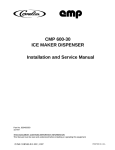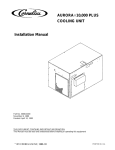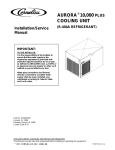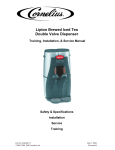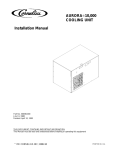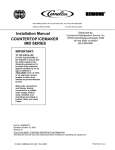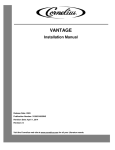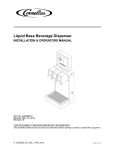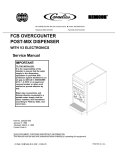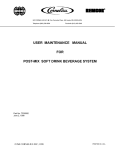Download Cornelius REMCOR R-134A User's Manual
Transcript
IMI CORNELIUS INC g One Cornelius Place g Anoka, MN 55303-6234 Telephone (800) 238-3600 Facsimile (612) 422-3246 Installation/Service Manual VENTURE POST--MIX DISPENSER W/BUILT--IN COLD CARBONATOR (R--134A REFRIGERANT) IMPORTANT: TO THE INSTALLER. It is the responsibility of the Installer to ensure that the water supply to the dispensing equipment is provided with protection against backflow by an air gap as defined in ANSI/ASME A112. 1.2-1979; or an approved vacuum breaker or other such method as proved effective by test. Water pipe connections and fixtures directly connected to a potable water supply shall be sized, installed, and maintained according to Federal, State, and Local laws. Part No. 312027000 July 18, 1995 Revised: April 1, 1999 Control Code D THIS DOCUMENT CONTAINS IMPORTANT INFORMATION This Manual must be read and understood before installing or operating this equipment Ó IMI CORNELIUS INC; 1995--99 PRINTED IN U.S.A TABLE OF CONTENTS Page SAFETY INFORMATION . . . . . . . . . . . . . . . . . . . . . . . . . . . . . . . . . . . . . . . . . . . . . . . . . . . . 1 RECOGNIZE SAFETY INFORMATION . . . . . . . . . . . . . . . . . . . . . . . . . . . . . . . UNDERSTAND SIGNAL WORDS . . . . . . . . . . . . . . . . . . . . . . . . . . . . . . . . . . . . 1 1 FOLLOW SAFETY INSTRUCTIONS . . . . . . . . . . . . . . . . . . . . . . . . . . . . . . . . . CO2 (CARBON DIOXIDE) WARNING . . . . . . . . . . . . . . . . . . . . . . . . . . . . . . . . SHIPPING, STORING, OR RELOCATING UNIT . . . . . . . . . . . . . . . . . . . . . . . GENERAL INFORMATION . . . . . . . . . . . . . . . . . . . . . . . . . . . . . . . . . . . . . . . . . . . . . . . . . . 1 1 1 3 GENERAL DESCRIPTION . . . . . . . . . . . . . . . . . . . . . . . . . . . . . . . . . . . . . . . . . . . . . . UNIT DESCRIPTION . . . . . . . . . . . . . . . . . . . . . . . . . . . . . . . . . . . . . . . . . . . . . . . . . . . WARRANTY REFERENCE INFORMATION . . . . . . . . . . . . . . . . . . . . . . . . . . . . . . . 3 3 4 THEORY OF OPERATION . . . . . . . . . . . . . . . . . . . . . . . . . . . . . . . . . . . . . . . . . . . . . . INSTALLATION . . . . . . . . . . . . . . . . . . . . . . . . . . . . . . . . . . . . . . . . . . . . . . . . . . . . . . . . . . . . 5 9 UNPACKING AND INSPECTION . . . . . . . . . . . . . . . . . . . . . . . . . . . . . . . . . . . . . . . . IDENTIFICATION OF LOOSE-SHIPPED PARTS . . . . . . . . . . . . . . . . . . . . . . . . . . . SELECTING LOCATION . . . . . . . . . . . . . . . . . . . . . . . . . . . . . . . . . . . . . . . . . . . . . . . . INSTALLING WATER ONLY LEVER KIT (P/N 3297) ON UF-1 DISPENSING VALVE . . . . . . . . . . . . . . . . . . . . . . . . . . . . . . . . . . . . . . . . . . . . . . . . . . . . . . . . . . . . . . . . 9 9 10 INSTALLING UNIT . . . . . . . . . . . . . . . . . . . . . . . . . . . . . . . . . . . . . . . . . . . . . . . . . . . . . CUTTING HOLE IN COUNTERTOP . . . . . . . . . . . . . . . . . . . . . . . . . . . . . . . . . CONNECTING PLAIN WATER SOURCE LINE(S) TO UNIT . . . . . . . . . . . . . CONNECTING SYRUP SOURCE LINES TO UNIT . . . . . . . . . . . . . . . . . . . . . CONNECTING CO2 SOURCE LINE TO UNIT . . . . . . . . . . . . . . . . . . . . . . . . . SEALING UNIT BASE TO COUNTERTOP . . . . . . . . . . . . . . . . . . . . . . . . . . . . PREPARING UNIT FOR OPERATION . . . . . . . . . . . . . . . . . . . . . . . . . . . . . . . . . . . . 10 10 10 12 13 13 13 FILL WATER TANK AND START REFRIGERATION SYSTEM . . . . . . . . . . . UNIT OPERATION . . . . . . . . . . . . . . . . . . . . . . . . . . . . . . . . . . . . . . . . . . . . . . . . . ADJUST WATER-TO-SYRUP “RATIO”(BRIX) OF DISPENSED PRODUCT OPERATOR’S INSTRUCTIONS . . . . . . . . . . . . . . . . . . . . . . . . . . . . . . . . . . . . . . . . . . . . . 10 13 14 15 17 OPERATING CONTROLS . . . . . . . . . . . . . . . . . . . . . . . . . . . . . . . . . . . . . . . . . . . . . . DISPENSING VALVE LEVER . . . . . . . . . . . . . . . . . . . . . . . . . . . . . . . . . . . . . . . DISPENSING VALVE WITH WATER LEVER . . . . . . . . . . . . . . . . . . . . . . . . . . 17 17 17 DISPENSING VALVES KEYED LOCK-OUT SWITCH . . . . . . . . . . . . . . . . . . UNIT POWER SWITCH (115 VAC, 60 HZ UNITS ONLY) . . . . . . . . . . . . . . . . CARBONATOR WATER PUMP MOTOR POWER SWITCH . . . . . . . . . . . . . DAILY PRE-OPERATION CHECK . . . . . . . . . . . . . . . . . . . . . . . . . . . . . . . . . . . . . . . . UNIT OPERATION . . . . . . . . . . . . . . . . . . . . . . . . . . . . . . . . . . . . . . . . . . . . . . . . . . . . . ADJUSTMENTS . . . . . . . . . . . . . . . . . . . . . . . . . . . . . . . . . . . . . . . . . . . . . . . . . . . . . . . ADJUSTING CO2 REGULATORS . . . . . . . . . . . . . . . . . . . . . . . . . . . . . . . . . . . 17 17 17 17 18 18 18 ADJUSTING DISPENSING VALVE WATER FLOW RATE . . . . . . . . . . . . . . ADJUSTING WATER-TO-SYRUP “RATIO”OF DISPENSED PRODUCT . . REPLENISHING CO2 SUPPLY . . . . . . . . . . . . . . . . . . . . . . . . . . . . . . . . . . . . . . . . . . REPLENISHING SYRUP SUPPLY . . . . . . . . . . . . . . . . . . . . . . . . . . . . . . . . . . . . . . . CLEANING AND SANITIZING . . . . . . . . . . . . . . . . . . . . . . . . . . . . . . . . . . . . . . . . . . . DAILY CLEANING OF UNIT . . . . . . . . . . . . . . . . . . . . . . . . . . . . . . . . . . . . . . . . 18 18 18 18 18 18 i 312027000 TABLE OF CONTENTS (cont’d) Page SANITIZING SYRUP SYSTEMS . . . . . . . . . . . . . . . . . . . . . . . . . . . . . . . . . . . . . CHECKING DROP-IN REFRIGERATION ASSEMBLY CONDENSER COIL FOR RESTRICTIONS . . . . . . . . . . . . . . . . . . . . . . . . . . . . . . . . . . . . . . . . . . . . . . . . . . CHECKING ICE WATER BATH . . . . . . . . . . . . . . . . . . . . . . . . . . . . . . . . . . . . . . . . . . CARBONATOR WATER PUMP YEARLY MAINTENANCE OR AFTER WATER SYSTEM DISRUPTIONS . . . . . . . . . . . . . . . . . . . . . . . . . . . . . . . . . . . . . . . . . . . . . . . CLEANING CO2 GAS CHECK VALVES . . . . . . . . . . . . . . . . . . . . . . . . . . . . . . . . . . SERVICE AND MAINTENANCE . . . . . . . . . . . . . . . . . . . . . . . . . . . . . . . . . . . . . . . . . . . . . 19 PREPARING UNIT FOR SHIPPING, STORING, OR RELOCATING . . . . . . . . . . HOOD AND FRONT PANEL REMOVAL . . . . . . . . . . . . . . . . . . . . . . . . . . . . . . . . . . 21 21 HOOD REMOVAL . . . . . . . . . . . . . . . . . . . . . . . . . . . . . . . . . . . . . . . . . . . . . . . . . FRONT ACCESS PANEL REMOVAL . . . . . . . . . . . . . . . . . . . . . . . . . . . . . . . . . PERIODIC INSPECTION . . . . . . . . . . . . . . . . . . . . . . . . . . . . . . . . . . . . . . . . . . . . . . . ADJUSTMENTS . . . . . . . . . . . . . . . . . . . . . . . . . . . . . . . . . . . . . . . . . . . . . . . . . . . . . . . ADJUSTING CO2 REGULATORS . . . . . . . . . . . . . . . . . . . . . . . . . . . . . . . . . . . ADJUSTING DISPENSING VALVES WATER FLOW RATE . . . . . . . . . . . . . 21 21 21 21 21 23 ADJUSTING WATER-TO-SYRUP “RATIO”(BRIX) OF DISPENSED PRODUCT . . . . . . . . . . . . . . . . . . . . . . . . . . . . . . . . . . . . . . . . . . . . . . . . . . . . . . . . CLEANING DROP-IN REFRIGERATION ASSEMBLY CONDENSER COIL . . . . CHECKING ICE WATER BATH . . . . . . . . . . . . . . . . . . . . . . . . . . . . . . . . . . . . . . . . . . CLEANING WATER TANK . . . . . . . . . . . . . . . . . . . . . . . . . . . . . . . . . . . . . . . . . . . . . . CLEANING AND SANITIZING . . . . . . . . . . . . . . . . . . . . . . . . . . . . . . . . . . . . . . . . . . . DAILY CLEANING OF UNIT . . . . . . . . . . . . . . . . . . . . . . . . . . . . . . . . . . . . . . . . 25 26 26 27 28 28 19 19 19 19 21 SANITIZING POST-MIX SYRUP SYSTEMS . . . . . . . . . . . . . . . . . . . . . . . . . . CARBONATOR WATER PUMP YEARLY MAINTENANCE OR AFTER WATER SYSTEM DISRUPTIONS . . . . . . . . . . . . . . . . . . . . . . . . . . . . . . . . . . . . . . . . . . . . . . . REPLENISHING CO2 SUPPLY . . . . . . . . . . . . . . . . . . . . . . . . . . . . . . . . . . . . . . . . . . REPLENISHING SYRUP SUPPLY . . . . . . . . . . . . . . . . . . . . . . . . . . . . . . . . . . . . . . . SYRUP TANK SYSTEM . . . . . . . . . . . . . . . . . . . . . . . . . . . . . . . . . . . . . . . . . . . . 29 BAG-IN-BOX SYRUP SYSTEM . . . . . . . . . . . . . . . . . . . . . . . . . . . . . . . . . . . . . SYRUP FLAVOR CHANGE . . . . . . . . . . . . . . . . . . . . . . . . . . . . . . . . . . . . . . . . . . . . . CLEANING CO2 SYSTEM CO2 GAS CHECK VALVES . . . . . . . . . . . . . . . . . . . . . TROUBLESHOOTING . . . . . . . . . . . . . . . . . . . . . . . . . . . . . . . . . . . . . . . . . . . . . . . . . . . . . . 35 35 35 42 TROUBLESHOOTING POST-MIX SYSTEM SYSTEM . . . . . . . . . . . . . . . . . . . . . . WATER-TO-SYRUP “RATIO”TOO LOW OR TOO HIGH . . . . . . . . . . . . . . . ADJUSTMENT OF DISPENSING VALVE SYRUP FLOW CONTROL DOES NOT INCREASE TO DESIRED WATER-TO-SYRUP “RATIO”. . . . . . . . . . . . ADJUSTMENT OF DISPENSING VALVE SYRUP FLOW CONTROL DOES NOT DECREASE TO DESIRED WATER-TO-SYRUP “RATIO”. . . . . . . . . . . DISPENSED PRODUCT CARBONATION TOO LOW. . . . . . . . . . . . . . . . . . . DISPENSED PRODUCT COMES OUT OF DISPENSING VALVE CLEAR BUT FOAMS IN CUP OR GLASS. . . . . . . . . . . . . . . . . . . . . . . . . . . . . . . . . . . . DISPENSED PRODUCT PRODUCES FOAM AS IT LEAVES DISPENSING VALVE. . . . . . . . . . . . . . . . . . . . . . . . . . . . . . . . . . . . . . . . . . . . . . . . . . . . . . . . . . . . NO PRODUCT DISPENSED FROM ALL DISPENSING VALVES. . . . . . . . . ONLY CARBONATED WATER DISPENSED. . . . . . . . . . . . . . . . . . . . . . . . . . . 312027000 ii 31 33 34 35 42 42 42 43 43 43 43 44 44 TABLE OF CONTENTS (cont’d) Page ONLY SYRUP DISPENSED. . . . . . . . . . . . . . . . . . . . . . . . . . . . . . . . . . . . . . . . . TROUBLESHOOTING REFRIGERATION SYSTEM . . . . . . . . . . . . . . . . . . . . 44 45 COMPRESSOR DOES NOT OPERATE. . . . . . . . . . . . . . . . . . . . . . . . . . . . . . COMPRESSOR WILL NOT STOP AFTER SUFFICIENT ICE BANK IS PRODUCED. (NOTE: ICE BANK SHOULD JUST COVER CONTROL BULB). . . . . . . . . . . . . . . . . . . . . . . . . . . . . . . . . . . . . . . . . . . . . . . . . . . . . . . . . . . . COMPRESSOR OPERATES CONTINUOUSLY BUT DOES NOT FORM SUFFICIENT ICE BANK. . . . . . . . . . . . . . . . . . . . . . . . . . . . . . . . . . . . . . . . . . . . AGITATOR MOTOR NOT OPERATING. . . . . . . . . . . . . . . . . . . . . . . . . . . . . . . 45 WARRANTY . . . . . . . . . . . . . . . . . . . . . . . . . . . . . . . . . . . . . . . . . . . . . . . . . . . . . . . . . . . . . . 47 45 46 46 LIST OF FIGURES FIGURE 1. VENTURE SIX-FLAVOR POST-MIX DISPENSER . . . . . . . . . . . . . . . FIGURE 2. FLOW DIAGRAM (FIVE-FLAVOR UNIT WITH BUILT-IN COLD CARBONATOR) . . . . . . . . . . . . . . . . . . . . . . . . . . . . . . . . . . . . . . . . . . . . . . . . . . . . . . . FIGURE 3. FLOW DIAGRAM (SIX-FLAVOR UNIT WITH BUILT-IN COLD CARBONATOR) . . . . . . . . . . . . . . . . . . . . . . . . . . . . . . . . . . . . . . . . . . . . . . . . . . . . . . . FIGURE 4. SYRUP INLET SUPPLY LINE CONNECTIONS (SIX-FLAVOR UNIT SHOWN) . . . . . . . . . . . . . . . . . . . . . . . . . . . . . . . . . . . . . . . . . . . . . . . . . . . . . . . . FIGURE 5. DISPENSER COMPONENTS . . . . . . . . . . . . . . . . . . . . . . . . . . . . . . . . . FIGURE 6. SF-1 DISPENSING VALVE . . . . . . . . . . . . . . . . . . . . . . . . . . . . . . . . . . . FIGURE 7. UF-1 DISPENSING VALVE . . . . . . . . . . . . . . . . . . . . . . . . . . . . . . . . . . . FIGURE 8. WATER TANK . . . . . . . . . . . . . . . . . . . . . . . . . . . . . . . . . . . . . . . . . . . . . . . FIGURE 9. WATER STRAINER SCREEN AND DOUBLE-LIQUID CHECK VALVE . . . . . . . . . . . . . . . . . . . . . . . . . . . . . . . . . . . . . . . . . . . . . . . . . . . . . . . . . . . . . . . . FIGURE 10. LIQUID CHECK VALVE ASSEMBLY . . . . . . . . . . . . . . . . . . . . . . . . . . FIGURE 11. CO2 GAS CHECK VALVE ASSEMBLY . . . . . . . . . . . . . . . . . . . . . . . . FIGURE 12. WIRING SCHEMATIC FOR ELECTRONIC ICE BANK CONTROL (OPTIONAL) . . . . . . . . . . . . . . . . . . . . . . . . . . . . . . . . . . . . . . . . . . . . . . . . . . . . . . . . . . FIGURE 13. WIRING DIAGRAM (50 AND 60 HZ UNIT WITH 1/3 H.P. REFRIGERATION ASSEMBLY) . . . . . . . . . . . . . . . . . . . . . . . . . . . . . . . . . . . . . . . . . . FIGURE 14. WIRING DIAGRAM (60 HZ UNIT WITH 1/4 H.P. REFRIGERATION ASSEMBLY AND BUILT-IN COLD CARBONATOR) . . . . . . . . . . . . . . . . . . . . . . . . FIGURE 15. WIRING DIAGRAM (50 HZ UNIT WITH 1/4 H.P. REFRIGERATION ASSEMBLY AND BUILT-IN COLD CARBONATOR) . . . . . . . . . . . . . . . . . . . . . . . . FIGURE 16. WIRING DIAGRAM (SF-1 DISPENSING VALVE) . . . . . . . . . . . . . . . FIGURE 17. WIRING DIAGRAM (UF-1 DISPENSING VALVE) . . . . . . . . . . . . . . . 3 6 7 11 22 23 24 28 33 34 35 36 37 38 39 40 40 LIST OF TABLES TABLE 1. DESIGN DATA . . . . . . . . . . . . . . . . . . . . . . . . . . . . . . . . . . . . . . . . . . . . . . . TABLE 2. LOOSE-SHIPPED PARTS . . . . . . . . . . . . . . . . . . . . . . . . . . . . . . . . . . . . . iii 4 9 312027000 SAFETY INFORMATION Recognize Safety Information This is the safety-alert symbol. When you see this symbol on our machine or in this manual, be alert to the potentially of personal injury. Follow recommended precautions and safe operating practices. Understand Signal Words A signal word - DANGER, WARNING, OR CAUTION is used with the safety-alert symbol. DANGER identifies the most serious hazards. Safety signs with signal word DANGER or WARNING are typically near specific hazards. General precautions are listed on CAUTION safety signs. CAUTION also calls attention to safety messages in this manual. DANGER WARNING CAUTION Follow Safety Instructions Carefully read all safety messages in this manual and on your machine safety signs. Keep safety signs in good condition. Replace missing or damaged safety signs. Learn how to operate the machine and how to use the controls properly. Do not let anyone operate the machine without instructions. Keep your machine in proper working condition. Unauthorized modifications to the machine may impair function and/or safety and affect the machine life. CO2 (Carbon Dioxide) Warning CO2 Displaces Oxygen. Strict Attention must be observed in the prevention of CO2 (carbon dioxide) gas leaks in the entire CO2 and soft drink system. If a CO2 gas leak is suspected, particularly in a small area, immediately ventilate the contaminated area before attempting to repair the leak. Personnel exposed to high concentration of CO2 gas will experience tremors which are followed rapidly by loss of consciousness and suffocation. Shipping, Storing, Or Relocating Unit CAUTION: Before shipping, storing, or relocating this Unit, the syrup systems must be sanitized and all sanitizing solution must be purged from the syrup systems. All water must also be purged from the plain and carbonated water systems. A freezing ambient temperature will cause residual water remaining inside the Unit to freeze resulting in damage to internal components of the Unit. 1 312027000 THIS PAGE LEFT BLANK INTENTIONALLY 312027000 2 GENERAL INFORMATION IMPORTANT: To the user of this manual - This manual is a guide for installing, operating, and maintaining this equipment. Refer to the Table of Contents for page location for detailed information pertaining to questions that arise during installation, operation, service, or maintenance of this equipment. GENERAL DESCRIPTION This section gives the Unit description, theory of operation, and design data for the five and six-flavor Ventures Post-Mix Dispensers with Built-In Cold Carbonators (hereafter referred to as Units). This Unit must be installed and serviced by a qualified Service Person. This Unit contains no User serviceable parts. UNIT DESCRIPTION The Units are compact with high-impact and corrosion-resistant moulded lower housings and may be islandmounted or installed on a front or rear counter. Their refrigeration assemblies are the 1/3 H.P. drop-in type that can be easily removed for service and maintenance. The Units are equipped with built-in cold carbonators with their carbonated water tanks located inside the Units lower housings water tanks. Adjustable syrup flow regulators, located on the electrically operated dispensing valves, are easily accessible to control water-to-syrup “Ratio”of the dispensed product. Installation of the Unit on a countertop, installation of LOOSE-SHIPPED PARTS, connection of plain water and syrup supplies, adjustment of CO2 regulators, filling water tank with water, and plugging the Unit power cord into an electrical outlet is all that is required for operation. NOTE: Optional 4-inch Legs (P/N 314744000) that will elevate the Unit 4-inches above the countertop are available. When ordering legs, order a quantity of four. CAUTION: Before shipping, storing, or relocating this Unit, the syrup systems must be sanitized and all sanitizing solution must be purged from the syrup systems. All water must also be purged from the plain and carbonated water systems. A freezing ambient environment will cause residual water in the Unit to freeze resulting in damage to internal components. FIGURE 1. VENTURE SIX-FLAVOR POST-MIX DISPENSER 3 312027000 WARRANTY REFERENCE INFORMATION Warranty Registration Date (to be filled out by customer) Unit Part Number: Serial Number: Install Date: Local Authorized Service Center: Table 1. Design Data Unit Part Numbers see Unit Nameplate Overall Dimensions: Width Height Depth 16-1/4 inches 27 5/8 inches 24 1/2 inches Weights: Shipping (one carton) Dry Weight (Approximate) Ice Bank Weight (approximate) Drop-In Refrigeration Assembly 127 Pounds 115 Pounds 30 Pounds 66 Pounds Water Tank Capacity (no ice bank) approximate 8-3/4 Gallons Dispensing Rate: 12-0z Drinks 2/min. or below *70 (see NOTE) NOTE: Number of drinks dispensed 40°F or below with 75°F syrup and water inlet temperature and 75°F ambient. Refrigeration System: Compressor Horsepower Refrigerant Type and Amount 1/3 H.P. See Unit Nameplate Ambient Operating Temperature 40°F to 100°F Electrical Requirements: 312027000 See Unit Nameplate 4 THEORY OF OPERATION (see applicable Figure 2 or 3) WARNING: CO2 displaces oxygen. Strict attention must be observed in the prevention of CO2 (carbon dioxide) gas leaks in the entire CO2 and soft drink system. If a CO2 gas leak is suspected, particularly in a small area, immediately ventilate the contaminated area before attempting to repair the leak. Personnel exposed to high concentration of CO2 gas will experience tremors which are followed rapidly by loss of consciousness and suffocation. NOTE: The six-flavor (see Figure 3) Unit was set up at the factory to dispense a still (noncarbonated) drink from No. 3 dispensing valve and carbonated drinks from the remaining dispensing valves. A CO2 cylinder delivers carbon dioxide (CO2) gas through adjustable CO2 regulators to applicable syrup tanks or bag-in-box syrup system syrup pumps and to a built-in carbonator located inside the Unit. Plain water is pumped into the carbonator carbonated water tank by a water pump and is carbonated by regulated CO2 gas pressure also entering the tank. When a dispensing valve is opened, CO2 gas pressure exerted upon the syrup tank or on the bag-in-box system syrup pump, pushes syrup through the Unit syrup cooling coils, and on to the dispensing valve. Carbonated water is pushed by CO2 gas pressure from the carbonated water tank and passes through the Unit carbonated water cooling coils, and on to the dispensing valve. Syrup and carbonated water meet simultaneously at the dispensing valve resulting in a carbonated drink being dispensed. On the six-flavor Unit, a still (noncarbonated) drink is dispensed from the No. 3 dispensing valve in the same manner as the carbonated drink except plain water is substituted for carbonated water. The carbonated water tank is replenished when the carbonated water level inside the tank drops, which in turn automatically starts the carbonator water pump. When the carbonated water level inside the tank has been replenished, the carbonated water pump will stop. 5 312027000 312027000 6 WATER PUMP DOUBLE LIQUID CHECK VALVE CO2 CHECK VALVE LINE LEGEND CO2 PLAIN WATER CARB WATER SYRUP CARBONATOR WATER TANK DISPENSER CAP NUT FIGURE 2. FLOW DIAGRAM (FIVE-FLAVOR UNIT WITH BUILT-IN COLD CARBONATOR) TANKS OR BAG-IN-BOX SYSTEM NOTE: SYRUP SOURCE MAY BE SYRUP CARBONATOR PLAIN WATER INLET CARBONATED WATER TANK CO2 INLET SYRUP 5 SYRUP 4 SYRUP 3 SYRUP 2 SYRUP 1 CARB WATER MANIFOLD 5 4 3 2 1 DISPENSING VALVE (5) 7 312027000 LINE LEGEND CO2 PLAIN WATER CARB WATER SYRUP CARBONATOR PLAIN WATER INLET CARBONATED WATER TANK CO2 INLET PLAIN WATER NO. 3 VALVE SYRUP 6 SYRUP 5 SYRUP 4 SYRUP 3 SYRUP 2 SYRUP 1 TANKS OR BAG-IN-BOX SYSTEM NOTE: SYRUP SOURCE MAY BE SYRUP CARBONATOR WATER TANK CARB WATER MANIFOLD DISPENSER 6 5 4 3 FIGURE 3. FLOW DIAGRAM (SIX-FLAVOR UNIT WITH BUILT-IN COLD CARBONATOR) WATER PUMP DOUBLE LIQUID CHECK VALVE CO2 CHECK VALVE CAP NUT 2 1 STILL DRINK (NON-CARB) DISPENSING VALVE (6) THIS PAGE LEFT BLANK INTENTIONALLY 312027000 8 INSTALLATION This section covers unpacking and inspection, selecting location, installing the Unit, preparing the Unit for operation, and Unit operation. UNPACKING AND INSPECTION NOTE: The Unit was thoroughly inspected before leaving the factory and the carrier has accepted and signed for it. Any damage or irregularities should be noted at the time of delivery (or not later than 15 days from date of delivery) and immediately reported to the delivering carrier. Request a written inspection report from Claims Inspector to substantiate any necessary claim. File claim with the delivering carrier, not with IMI Cornelius Inc. 1. After the Unit has been unpacked, remove shipping tape and other packing material. 2. Lift hood straight up and off the Unit. 3. Remove four shipping hex nuts that secure the drop-in refrigeration assembly in the Unit. 4. Unpack LOOSE-SHIPPED PARTS. Make sure all items are present and in good condition. Table 2. Loose-Shipped Parts Item No. Part No. Name 5-FL 6-FL 1 317659039 Drip Tray 1 1 2 317660000 Cup Rest 1 1 3 3573 Rear access Panel 1 1 4 17619300 Adaptor Fitting, 7/16-20 (2) -- 1 5 187254000 Sheet Metal Screw, Phil Truss Hd; Type A, No. 6 by 3/8-in. Long 2 2 6 318516000 Drain Hose Clamp 1 1 7 311304000 Tapered Gasket, Black 2 2 8 309852000 Tubing Clamp, .669 I.D. Open .571 I.D. Closed 2 2 9 77040900 Fitting, 90°Swivel Elbow 1 1 10 3297 Water Only Lever Kit, UF-1 Dispensing Valve (see Note) -- 1 NOTE: Loose-shipped with Six-Flavor Dispensers equipped UF-1 dispensing valves. IDENTIFICATION OF LOOSE-SHIPPED PARTS 1. DRIP TRAY (item 1) to be installed on the Unit, then CUP REST (item 2) to be installed in the drip tray. 2. REAR ACCESS PANEL (item 3) to be installed over Unit base back access hole if power cord, drain hoses, and inlet supply lines will not be routed out back of the Unit. Rear access panel to be secured to the Unit with SHEET METAL SCREWS (item 5). 3. FITTING (item 4) is used to connect plain water inlet source line to the six-flavor Dispenser plain water inlet line that provides plain water to the No. 3 dispensing valve. 4. DRAIN HOSE CLAMP (item 6) is used to connect drain hose (not provided) to the Dispenser drip tray. 5. FITTING, 90°SWIVEL ELBOW (item 9) is used to connect plain water source line to the carbonator water pump inlet fitting. TAPERED GASKET, BLACK (item 7) is used to seal the connection.TUBING CLAMP (item 8) is used to secure the plain water source inlet line when connected to the 90°swivel elbow installed on the carbonator water pump. 9 312027000 SELECTING LOCATION CAUTION: This Unit is intended for indoor installation only. Do not install this Unit in an outdoor environment which would expose it to the outside elements. This Unit may be island-mounted or installed on a front or rear counter. Locate the Unit so the following requirements are satisfied: DANGER: To avoid possible fatal electrical shock or serious injury to the operator, it is required that a GFCI (ground fault circuit interrupt) be installed in the electrical circuit for the domestic Units. It is required that an ELCB (earth leakage circuit breaker) be installed in the electrical circuit for the export Units 1. The Unit must be installed near a properly grounded electrical outlet with proper electrical requirements.The electrical circuit must be properly fused (slow-blow type fuse) or the circuit must be connected through an equivalent HACR circuit breaker.The electrical outlet must be accessible for ease of connecting and disconnecting the Unit power cord. No other electrical equipment should be connected to this circuit. REFER TO UNIT NAMEPLATE FOR THE REQUIRED POWER CIRCUIT OPERATING VOLTAGE, HZ, AND THE MINIMUM CIRCUIT AMPACITY OF THE UNIT. ALL ELECTRICAL WIRING MUST CONFORM TO NATIONAL AND LOCAL ELECTRICAL CODES. CAUTION: Do not place or store anything on top of the Unit. 2. A minimum of 15-inches clearance must be maintained above the Unit to the nearest obstruction (shelf, cupboard, ceiling, etc.) and 6-inches clearance between back-side of the Unit and the wall. The front grille of the Unit must be unobstructed to allow air to enter the hood. 3. Close to a permanent drain to route drip tray drain hose and water tank drain hose. INSTALLING WATER ONLY LEVER KIT (P/N 3297) ON UF-1 DISPENSING VALVE The WATER ONLY LEVER KIT, UF-1 DISPENSING VALVE (item 10) is loose-shipped with all six-flavor Dispensers equipped with UF-1 dispensing valves. Installation of this kit on the dispensing valve allows plain or carbonated (depending on which dispensing valve the kit has been installed on) water only to be dispensed. If desired, the kit may be installed at this time following instructions included with the kit. INSTALLING UNIT NOTE: Optional 4-inch Legs (P/N 314744000) that will elevate the Unit 4-inches above the countertop are available. When ordering legs, order a quantity of four. CUTTING HOLE IN COUNTERTOP Place Unit in location on the countertop flush with the countertop edge. Mark Unit center line on edge of the countertop, then move Unit off to one side. Starting at center line mark on edge of the countertop, measure back 8-inches for location of the 2-1/2-inch diameter hole to be cut in the countertop. Cut a 2-1/2-inch hole in the countertop where indicated. Place the Unit in position over the hole. CONNECTING PLAIN WATER SOURCE LINE(S) TO UNIT (see applicable Figure 2 or 3 and Figure 4) NOTE: IMI Cornelius Inc. recommends that a water shutoff valve and water filter be installed in the plain water inlet supply line (see applicable Figure 2 or 3) . A Cornelius Water Filter (P/N 313860000) and Quick Disconnect Set (P/N 313867000) are recommended. 312027000 10 DISPENSING VALVE RELEASE LATCH DISPENSING VALVE BLOCK SYRUP INLET TUBES (6) FIGURE 4. SYRUP INLET SUPPLY LINE CONNECTIONS (SIX-FLAVOR UNIT SHOWN) 11 312027000 IMPORTANT: TO THE INSTALLER. It is the responsibility of the Installer to ensure that the water supply to the dispensing equipment is provided with protection against backflow by an air gap as defined in ANSI/ASME A112. 1.2-1979; or an approved vacuum breaker or other such method as proved effective by test. Water pipe connections and fixtures directly connected to a potable water supply shall be sized, installed, and maintained according to Federal, State, and Local laws. CAUTION: Check the minimum flow rate and maximum pressure of plain water inlet supply line. MINIMUM FLOW RATE MUST BE AT LEAST 100-GALLONS PER HOUR. If flow rate is less than 100-gallons per hour, starving of carbonator water pump will occur. Starving will allow water pump to overheat and will damage the pump. Overheating could occur if plain water inlet supply line flow rate drops below 100-gallons per hour. CARBONATOR CO2 OPERATING PRESSURE MUST EXCEED WATER PRESSURE BY 10 PSI. (Example: CO2 operating pressure is 80 psi, maximum water pressure can be no more than 70 psi, etc.) Water over pressure (higher than CO2 operating pressure) can cause carbonator flooding, malfunction, and leakage through carbonator relief valve. If water is exceeding maximum pressure specifications, a Water Pressure Regulator Kit (P/N 317589000) or equivalent must be installed in plain water inlet supply line. Five and Six-Flavor Units (see applicable Figure 2 or 3) 1. Route plain water source line from plain water source up to location under the countertop. 2. Remove Unit front access panel as follows: A. Remove drip tray from the Unit. B. Remove two screws securing front access panel to the Unit. C. Pull front access panel down and out to remove for access to front of the Unit. 3. Route plain water source line up through hole cut in the countertop, up across front of the Unit, to the carbonator water pump. 4. Install FITTING, 90°SWIVEL ELBOW (item 9) on end of the plain water source line and secure with TUBING CLAMP (item 8). 5. Connect plain water source line 90°elbow to the carbonator water pump inlet fitting. Seal connection with TAPERED GASKET, BLACK (item 7). Six-Flavor Units (see Figure 3) NOTE: The six-flavor (see Figure 3) Unit was set up at the factory to dispense a still (noncarbonated) drink from No. 3 dispensing valve and carbonated drinks from the remaining dispensing valves. 1. Route plain water source line up to back side of the Unit. 2. Connect plain water source line to the Unit labeled plain water inlet line protruding out back of the Unit with ADAPTOR FITTING (item 4). This water line provides plain water to the Unit No. 3 dispensing valve which dispenses a still (non-carbonated) drink. CONNECTING SYRUP SOURCE LINES TO UNIT (see applicable Figure 2 or 3 and Figure 4) NOTE: The Unit syrup inlet lines are labeled to identify the dispensing valves they serve. For example, the line labeled “S1” must be connected to the syrup source line that provides syrup to be dispensed from the No. 1 dispensing valve (No. 1 dispensing valve is the valve on the right side when facing front of the Unit). 312027000 12 1. Route syrup source lines from the syrup tanks location up to location under the countertop. 2. Route syrup source lines up through hole cut in the countertop to the barbed and labeled syrup inlet lines on front of the Unit. 3. Connect the syrup source lines to the Unit barbed and labeled syrup inlet lines. Secure connections with tubing clamps. CONNECTING CO2 SOURCE LINE TO UNIT (see applicable Figure 2 or 3 and Figure 4) 1. Route CO2 source line up to back side of the Unit. 2. Connect CO2 source line to Unit labeled CO2 inlet line. Seal connection with a tapered gasket. SEALING UNIT BASE TO COUNTERTOP 1. To comply with NSF International (NSF) requirements within the United States, the Unit base must be sealed to the countertop and all access holes to the Unit base must be completely sealed with a silastic sealant such as Dow Corning RTV 731 or equivalent after completing installation of the Unit. Proceed as follows to seal the Unit base to the countertop. A. Tilt Unit up to expose bottom of the Unit base. B. Connect a length of drain hose (not provided), long enough to reach a permanent drain, to drain fitting on back side of the drip tray pan. Secure connection with DRAIN HOSE CLAMP (item 6). C. Liberally apply silastic sealant such as Dow Corning RTV 731 or equivalent on the Unit base bottom edges. NOTE: Do not move Unit after positioning or seal from base to countertop will be broken. D. Route drip tray drain hose down through hole in countertop, then lower Unit into operating position on the countertop to complete seal from Unit base to the countertop. E. Apply additional sealant around bottom of the base.The seal must have a minimum radius of 1/2-inch to prevent crevices and to ensure a complete seal. NOTE: Connection of drip tray drain hose to a permanent drain is recommended. Drip tray drain hose routed to waste container is not recommended due to sanitation and cleaning problems. F. Route lower end of drip tray drain hose to and connect to a permanent drain. G. Install DRIP TRAY (item 1) in position on the Unit, then place CUP REST (item 2) in the drip tray. PREPARING UNIT FOR OPERATION FILL WATER TANK AND START REFRIGERATION SYSTEM (see Figure 5) 1. Make sure plug in the water tank drain hose is secure. NOTE: Use low-mineral-content water where a local water problem exists. 2. Remove plug from the drop-in refrigeration assembly platform water fill hole. Fill the water tank with clean water until water runs out of the overflow groove on top front of the tank into the drip tray. USE LOW-MINERAL-CONTENT WATER WHERE A LOCAL WATER PROBLEM EXISTS. When the water tank is full, the water level in the clear plastic water level tube should be approximately one inch from end of the tube. 13 312027000 3. Install plug in water fill hole. 4. 115 VAC, 60 HZ Units. Make sure the main power switch on right side of the Unit (see Figure 5) is in the “OFF”position. 115 VAC, 60 HZ Units and 230 VAC, 50 HZ Units. Make sure the carbonator water pump motor power switch located on the drop-in refrigeration assembly electrical control box (see Figure 5) is in the “OFF”position. WARNING: Unit must be electrically grounded to avoid possible fatal electrical shock or serious injury to the operator. Unit power cord is equipped with a three-prong plug. If a three-hole (grounded) electrical outlet is not available, use an approved method to ground the Unit. 5. Plug Unit power cord into a properly grounded electrical outlet. 6. 115 VAC, 60 HZ Units. A. Plug Unit power cord into an accessible and properly grounded electrical outlet with GFCI (ground fault circuit interrupt). B. Place Unit main power switch on right side of the Unit in the “ON”position. The compressor, condenser fan motor, and agitator motor will start and begin forming an ice bank. When full ice bank has been formed, the compressor and condenser fan motor will stop but the agitator motor will continue to operate circulating ice water bath in the water tank. 7. 230 VAC, 50 HZ Units. A. Plug Unit power cord into an accessible and properly grounded electrical outlet with ELCB (earth leakage circuit breaker). The compressor, condenser fan motor, and agitator motor will start and begin forming an ice bank. When full ice bank has been formed, the compressor and condenser fan motor will stop but the agitator motor will continue to operate circulating ice water bath in the water tank. UNIT OPERATION WARNING: CO2 displaces oxygen. Strict attention must be observed in the prevention of CO2 (carbon dioxide) gas leaks in the entire CO2 and soft drink system. If a CO2 gas leak is suspected, particularly in a small area, immediately ventilate the contaminated area before attempting to repair the leak. Personnel exposed to high concentration of CO2 gas will experience tremors which are followed rapidly by loss of consciousness and suffocation. CAUTION: Before opening CO2 cylinder shutoff valve, turn secondary CO2 regulators adjusting screws to the left (counterclockwise) until all tension is relieved from adjusting screws springs. 1. Open (counterclockwise) the CO2 cylinder shutoff valve slightly to allow the lines to slowly fill with gas, then open the valve fully to back-seat the valve. (back-seating the valve prevents leakage around the valve shaft). Check for CO2 leaks. 2. Adjust CO2 regulator (regulator that controls the Unit built-in cold carbonator CO2 pressure) as instructed in the SERVICE AND MAINTENANCE section of this manual. Check for CO2 leaks and repair if evident.. 312027000 14 3. Open the plain water inlet supply line shutoff valve. Check for water leaks and tighten any loose connections. 4. Place the carbonator water pump motor power switch (located on the refrigeration assembly control box) in the “ON”position. The carbonator water pump will start and continue to operate until the carbonated water tank has been filled, then the water pump motor will stop. Check for CO2, plain water, and carbonated water leaks and tighten any loose connections. 5. Adjust the syrup tanks CO2 regulators as instructed in SERVICE AND MAINTENANCE section of this manual. 6. Install full syrup tanks into the syrup systems. 7. Make sure keyed lock-out switch (left-side facing front of Unit) is in the “ON”(vertical) position. 8. Dispense from each dispensing valve until air is bled from the systems and until syrup and applicable plain or carbonated water are dispensed. 9. Check for syrup and water leaks and repair any leaks. 10. Install the Unit hood and secure with screw. ADJUST WATER-TO-SYRUP “RATIO” (BRIX) OF DISPENSED PRODUCT 1. Adjust the dispensing valves for water flow rate as instructed in SERVICE AND MAINTENANCE section of this manual. 2. Adjust the dispensing valves for Water-to-Syrup “Ratio”(Brix) of dispensed product as instructed in SERVICE AND MAINTENANCE section of this manual. 3. Seal all access holes to the Unit with a silastic sealant such as Dow Corning RTV 731 or equivalent. 4. Install Unit front access panel and secure with two screws. 5. Install drip tray on the Unit. 15 312027000 THIS PAGE LEFT BLANK INTENTIONALLY 312027000 16 OPERATOR’S INSTRUCTIONS This section covers operating controls, daily pre-operation check, Unit operation, adjustments, replenishing CO2 and syrup supplies, cleaning and sanitizing, checking the drop-in refrigeration assembly condenser coil for restrictions, checking the ice water bath, water pump yearly maintenance, and periodic cleaning of the CO2 gas check valves. WARNING: Disconnect electrical power to the Unit to prevent personal injury before attempting any internal maintenance. Only qualified personnel should service the internal components or electrical wiring. CAUTION: Do not place or store anything on top of the Unit. OPERATING CONTROLS (see Figure 5) DISPENSING VALVE LEVER The dispensing valve lever, located on bottom of the valve, needs only to be pressed with cup or glass to dispense product. DISPENSING VALVE WITH WATER LEVER The dispensing valve water lever will dispense only water when actuated. DISPENSING VALVES KEYED LOCK-OUT SWITCH The dispensing valves keyed lock-out switch, located on the left side of Unit (see Figure 5), must be in the “ON” (vertical) position to operate the electric dispensing valves. The keyed lock-out switch in the “OFF”(horizontal) position turns off electrical power to the dispensing valves only, but the refrigeration system will continue to operate. UNIT POWER SWITCH (115 VAC, 60 HZ UNITS ONLY) The Unit power switch, located on the right side of the Unit (see Figure 5), must be in the “ON”position before the Unit will operate. CARBONATOR WATER PUMP MOTOR POWER SWITCH The carbonator water pump motor power switch, located on the refrigeration assembly control box, (see Figure 5), must be in the “ON”position before the carbonator water pump motor will operate. The purpose of the power switch is to turn off the carbonator water pump motor for service and maintenance. THE WATER SUPPLY TO THE CARBONATOR WATER PUMP MUST BE TURNED ON BEFORE RESTARTING THE CARBONATOR. STARVING THE WATER PUMP OF WATER WILL DAMAGE THE PUMP. DAILY PRE-OPERATION CHECK 1. Check CO2 cylinder regulator assembly 1800-psi gage and if the gage indicator is in the shaded (“change CO2 cylinder”) portion of the dial, the CO2 cylinder is almost empty and must be replaced. 17 312027000 2. Make sure there is a sufficient syrup supply. If not, replenish the syrup supply as instructed in SERVICE AND MAINTENANCE section in this manual. 3. Make sure drip tray and cup rest are clean and are properly installed on the Unit. UNIT OPERATION 1. Make sure dispensing valves keyed lock-out switch on left side of the Unit is in the “ON”(vertical) position. 2. Press cup or glass against the dispensing valve lever and dispense until the cup or glass is full of product, then release the lever. 3. If water only is desired, hold cup or glass under the dispensing valve with lever on its side, then actuate the lever to dispense water. ADJUSTMENTS ADJUSTING CO2 REGULATORS The CO2 regulators should be checked periodically for proper pressure settings and be adjusted if necessary. Refer to SERVICE AND MAINTENANCE section in this manual for adjustment instructions. ADJUSTING DISPENSING VALVE WATER FLOW RATE The water flow rate of the dispensing valves may be adjusted. Refer to SERVICE AND MAINTENANCE section in this manual for adjustment instructions. ADJUSTING WATER-TO-SYRUP “RATIO” OF DISPENSED PRODUCT The Water-to-Syrup “Ratio”(Brix) of the dispensed product should be checked periodically and adjusted if necessary. Refer to SERVICE AND MAINTENANCE section in this manual for adjustment instructions. REPLENISHING CO2 SUPPLY WARNING: CO2 displaces oxygen. Strict attention must be observed in the prevention of CO2 (carbon dioxide) gas leaks in the entire CO2 and soft drink system. If a CO2 gas leak is suspected, particularly in a small area, immediately ventilate the contaminated area before attempting to repair the leak. Personnel exposed to high concentration of CO2 gas will experience tremors which are followed rapidly by loss of consciousness and suffocation. The CO2 supply should be checked daily and replenished if necessary. Refer to SERVICE AND MAINTENANCE section in this manual for replenishing procedure. REPLENISHING SYRUP SUPPLY The syrup supply should be checked daily and replenished if necessary. Refer to SERVICE AND MAINTENANCE section in this manual for replenishing instructions. CLEANING AND SANITIZING DAILY CLEANING OF UNIT The daily cleaning procedure for the Unit should be performed at the end of the daily operation. Refer to SERVICE AND MAINTENANCE section in this manual for daily cleaning procedure. 312027000 18 SANITIZING SYRUP SYSTEMS The syrup systems should be sanitized as instructed every 90-days. Refer to SERVICE AND MAINTENANCE section in this manual for sanitizing instructions. CHECKING DROP-IN REFRIGERATION ASSEMBLY CONDENSER COIL FOR RESTRICTIONS NOTE: Circulating air required to cool the refrigeration assembly condenser coil is drawn in through the grille on front and is exhausted through grille on top of the hood. Restricting air in or out of the Unit will decrease its cooling efficiency. Area on top of the hood must be kept free of obstructions at all times. Make sure nothing is stored on top of the hood. The refrigeration assembly condenser coil should be periodically cleaned to maintain cooling efficiency as instructed in the SERVICE AND MAINTENANCE section of this manual. CHECKING ICE WATER BATH A “gurgle”heard from the Unit indicates the water level in the water tank is low and more water should be added for maximum product cooling. The water adding procedure may be found in the SERVICE AND MAINTENANCE section of this manual. CARBONATOR WATER PUMP YEARLY MAINTENANCE OR AFTER WATER SYSTEM DISRUPTIONS The water pump water strainer screen and the double-liquid check valve must be inspected and cleaned as instructed at least once a year under normal circumstances and after any water system disruption (plumbing work, earthquake, etc.). Refer to SERVICE AND MAINTENANCE section of this manual for inspecting and cleaning procedure. CLEANING CO2 GAS CHECK VALVES The CO2 gas check valves must be inspected and serviced as instructed at least once a year under normal conditions and after any CO2 system servicing or disruption. Servicing of the CO2 gas check valves should be performed by qualified Service Person. Refer to SERVICE AND MAINTENANCE section in this manual for inspecting and servicing procedures. 19 312027000 THIS PAGE LEFT BLANK INTENTIONALLY 312027000 20 SERVICE AND MAINTENANCE This section describes service and maintenance procedures to be performed on the Unit. IMPORTANT: Only qualified personnel should service internal components or electrical wiring. WARNING: Disconnect electrical power to the Unit to prevent personal injury before attempting any internal maintenance. Only qualified personnel should service the internal components or electrical wiring. PREPARING UNIT FOR SHIPPING, STORING, OR RELOCATING CAUTION: Before shipping, storing, or relocating this Unit, the syrup systems must be sanitized and all sanitizing solution must be purged from the syrup systems. All water must also be purged from the plain and carbonated water systems. A freezing ambient environment will cause residual water in the Unit to freeze resulting in damage to internal components. HOOD AND FRONT PANEL REMOVAL (see Figure 5) HOOD REMOVAL CAUTION: Do not place or store anything on top of the Unit. Loosen screw on top of hood, then lift hood straight up and off Unit. FRONT ACCESS PANEL REMOVAL 1. Remove drip tray from the Unit. 2. Remove two screws securing the front access panel to the Unit. 3. Pull the front access panel down and out to remove. PERIODIC INSPECTION 1. Check the refrigeration condenser coil for obstructions and dirt. DO NOT place objects in front of or on top of the hood. Restricting circulating air in or out of the Unit will decrease its cooling efficiency. 2. Check the dispensing valves for dripping that indicates leaking and repair as necessary. ADJUSTMENTS ADJUSTING CO2 REGULATORS WARNING: CO2 displaces oxygen. Strict attention must be observed in the prevention of CO2 (carbon dioxide) gas leaks in the entire CO2 and soft drink system. If a CO2 gas leak is suspected, particularly in a small area, immediately ventilate the contaminated area before attempting to repair the leak. Personnel exposed to high concentration of CO2 gas will experience tremors which are followed rapidly by loss of consciousness and suffocation. 21 312027000 AGITATOR MOTOR HOOD RETAINING SCREW (1) COMPRESSOR CONDENSER FAN MOTOR BUILT-IN COLD CARBONATOR POWER CORD CONDENSER COIL CONTROL BOX WATER FILL HOLE PLUG DISPENSING VALVES KEYED-LOCK SWITCH DISPENSING VALVE SYRUP FLOW REGULATOR DISPENSING VALVE LEVER DISPENSING VALVE COVER WITH WATER LEVER CUP REST FRONT PANEL WATER PUMP MOTOR WATER PUMP SHIPPING NUT (4) MAIN POWER SWITCH (115VAC UNIT ONLY) DRIP TRAY DISPENSING VALVE RELEASE LATCH MOUNTING BLOCK FIGURE 5. DISPENSER COMPONENTS 312027000 22 NOTE: To readjust CO2 regulator to a lower setting, loosen adjusting screw lock nut, then turn screw to the left (counterclockwise) until pressure gage reads 5 psi lower than new setting will be. Turn the adjusting screw to the right (clockwise) until the gage registers new setting, then tighten the lock nut. Adjusting Carbonator CO2 Regulator. Adjust primary CO2 regulator (regulator controls Unit built-in cold carbonator CO2 pressure) to a nominal 80 psig. Check for CO2 leaks and repair if evident. INLET CO2 PRESSURE TO CARBONATOR MUST NOT EXCEED 125 PSIG. Sugar Syrup Tanks Secondary CO2 Regulator. Adjust sugar syrup tanks secondary CO2 regulator with 100 psi gage at 40 psig for syrup lines up to 10 feet in length plus one pound for each additional length of 10 feet, plus one pound for each 2 feet of vertical lift. For example; if syrup line total length is 30 feet and total vertical lift is 6 feet, then 40 psig + 2 psig (1-pound for every 10 feet of length over 10 feet which is 20 feet) + 3 psig (1 pound for every 2 feet of vertical lift which is 6 feet); total equals 40 + 2 + 3 = 45 psig CO2 regulator setting. Loosen lock nut on CO2 regulator adjusting screw, turn adjusting screw to the right (clockwise) until gage registers desired pressure, then tighten lock nut. Low-Calorie (Diet) Syrup Tank Secondary CO2 Regulator Adjust low-calorie (diet) soft drink tank secondary CO2 regulator with 30 psi gage to 10 psig for syrup lines up to 30 feet in length. Syrup lines longer than 30 feet in length may require a slightly higher CO2 regulator setting of 12 psig maximum. Excessive CO2 pressure may cause low-calorie syrup carbonation resulting in foam. ADJUSTING DISPENSING VALVES WATER FLOW RATE SF-1 Dispensing Valve. (see Figure 6) 1. Remove acorn nut securing the dispensing valve cover, then remove the cover to expose the valve water and the syrup flow controls. 2. Remove dispensing valve nozzle by turning nozzle counterclockwise and pulling down. 3. Remove syrup diffuser by pulling straight down. ADJUSTABLE WATER FLOW REGULATOR ADJUSTABLE SYRUP FLOW REGULATOR NOZZLE SYRUP DIVERSION TUBE ASS’Y (P/N 319540000) WATER CHAMBER RATIO CUP (P/N 311100000) FIGURE 6. SF-1 DISPENSING VALVE 23 312027000 4. Install syrup separator on dispensing valve in place of the nozzle. 5. Measure the water flow rate by dispensing water into a graduated cup for a set period of time. Factory-set flow rate is approximately 1.25 ounces per second. 6. Adjust the water flow control adjusting screw clockwise for a greater flow or counterclockwise for lesser flow. Limit your adjustment to 1/4 turn at a time, then recheck the flow rate. Only the water flow rate is to be adjusted now. Syrup flow rate is adjusted in the Water-to Syrup “Ratio”(Brix) Adjustment section. UF-1 Dispensing Valve (see Figure 7) 1. Remove cover from the dispensing valve by lifting the front cover up 1/4 inch and pulling forward. 2. Install syrup diversion tube assembly on the dispensing valve by pushing rubber end of the syrup diversion tube onto the syrup outlet of the inner nozzle. 3. Measure the water flow rate by dispensing water into a graduated cup for a set period of time. NOTE: Adjusting screw stops are built into the valve to prevent leakage when the screws are adjusted too far clockwise. Stop adjusting clockwise when turning resistance increases. Turn the screw counterclockwise 1--1/2 turns after the stop are contacted. 4. Turn the water flow regulator adjusting screw to the left (counterclockwise) to decrease the water flow rate or turn the adjusting screw to the right (clockwise) to increase the water flow rate, then recheck the flow rate. Adjustments should be no more than 1/4 turn at a time. 5. Remove syrup diversion tube from the dispensing valve, then install cover on the dispensing valve. WATER FLOW REGULATOR SYRUP FLOW REGULATOR INNER NOZZLE Counterclockwise to Decrease Clockwise to Increase NOZZLE SYRUP DIVERSION TUBE RATIO CUP 312027000 FIGURE 7. UF-1 DISPENSING VALVE 24 ADJUSTING WATER-TO-SYRUP “RATIO” (BRIX) OF DISPENSED PRODUCT SF-1 Dispensing Valve. (see Figure 6) NOTE: Make sure the dispensing valve water flow rate is as desired before adjusting the valve for Water-to-Syrup ‘‘Ratio’’(Brix) of the dispensed product. Adjust Water-to-Syrup ‘‘Ratio’’of dispensed product by using Ratio Cup (P/N 311100000) and Syrup Diversion Tube Assembly (P/N 319540000) as follows. 1. Remove acorn nut securing the dispensing valve cover, then remove cover from the valve. 2. Install the syrup diversion tube assembly on the dispensing valve by pushing the rubber end of the syrup diversion tube up on the baffle inside the nozzle. NOTE: Refer to syrup manufacturer’s recommendations on syrup package for Water-to-Syrup ‘‘Ratio’’. 3. Hold container under the dispensing valve. Open the dispensing valve and dispense just enough to fill the syrup diversion tube with syrup. 4. Hold large chamber of the ratio cup under the dispensing valve nozzle. Place free end of the syrup diversion tube into syrup chamber marked for proper ratio. Open the dispensing valve and dispense approximately five ounces of water into the ratio cup. Water and syrup levels should be even in the ratio cup. 5. Adjusting Syrup Flow Regulator. If water and syrup levels are not even in ratio cup, turn dispensing valve syrup flow regulator labeled ‘‘SYRUP’’adjusting screw to the left (counterclockwise) no more than 1/4-turn at a time for less syrup or to the right (clockwise) no more than 1/4-turn at a time for more syrup. 6. Repeat Water-to-Syrup ‘‘Ratio’’test and adjust the syrup flow regulator as many times as necessary until proper ratio of the dispensed drink is achieved. 7. Remove syrup diversion tube assembly from the dispensing valve. 8. Install the dispensing valve cover and secure with acorn nut. UF-1 Dispensing Valve (see Figure 7) NOTE: Make sure the dispensing valve water flow rate is as desired before adjusting the valve for Water-to-Syrup ‘‘Ratio’’(Brix) of the dispensed product. Adjust Water--to--Syrup “Ratio”(Brix) of the dispensed product by using ratio cup (P/N 311100000) and syrup diversion tube assembly (P/N 319540000) as follows: 1. Remove cover from the dispensing valve by lifting front cover up 1/4 inch and pulling forward. 2. Install syrup diversion tube assembly on the dispensing valve by pushing the rubber end of the syrup diversion tube onto the syrup outlet of the inner nozzle. Notice: Refer to syrup manufacturer’s recommendations on syrup package for water-to-syrup ratio. 3. Dispense enough to fill syrup diversion tube with syrup. 4. Hold large chamber of the ratio cup under the dispensing valve nozzle. Place free end of the syrup diversion tube into the syrup chamber marked for the proper ratio. Dispense approximately 6 ounces of water into the ratio cup. Water and syrup levels should be even in cup. Note: Adjusting screw stops are built into the valve to prevent leakage when the screws are adjusted clockwise too much. Stop adjusting clockwise when turning resistance increases. Turn the screw counterclockwise 1--1/2 turns after the stop are contacted. 25 312027000 5. Adjusting Syrup Flow Regulator -- If water and syrup levels are uneven in the ratio cup, adjust by turning the dispensing valve syrup flow regulator adjusting screw labeled SYRUP as follows. A. For less syrup, turn the adjusting screw counterclockwise no more than 1/4 turn at a time. B. For more syrup, turn the adjusting screw clockwise no more than 1/4 turn at a time. 6. Repeat water-to-syrup ratio test and adjust syrup flow regulator as many times as necessary until proper ratio of dispensed drink is achieved. 7. Remove syrup diversion tube assembly from dispensing valve. 8. Install dispensing valve front cover. CLEANING DROP-IN REFRIGERATION ASSEMBLY CONDENSER COIL (see Figure 5) Excessive accumulation of dust, lint, and grease on the drop-in refrigeration assembly condenser coil will restrict air flow through the coil and cause a loss of cooling. Perform the following procedure to clean the condenser coil. 1. Unplug Unit power cord from electrical outlet. 2. Remove hood by loosening screw on top of the hood, then lift the hood straight up off the Unit. 3. Vacuum or use a soft brush to clean the condenser coil. If available, use compressed air to blow dust and debris out of the condenser coil. 4. Clean dust and dirt from around top of the refrigeration assembly. 5. Install hood on the Unit and secure with one screw. 6. Plug Unit power cord into electrical outlet. CHECKING ICE WATER BATH (see Figure 5) A “gurgle”heard from the Unit indicates water level in the water tank is low and more water should be added to the tank for maximum cooling. Before adding more water, ice water bath and ice bank should be checked for cleanliness and the water tank coils checked for excessive mineral deposit build-up. 1. Unplug Unit power cord from electrical outlet. 2. Remove Unit hood by loosening one screw on top of the hood, then lift the hood straight up off the Unit. 3. Remove plug from the drop-in refrigeration assembly platform water fill hole. 4. Using a flashlight, inspect the ice water bath and the ice bank for cleanliness. The ice water bath should be clear and the ice bank should be free of foreign particles. 5. If cleaning of the water tank is necessary, refer to CLEANING WATER TANK in this section. 6. Fill the water tank with clean water until water runs out of the overflow groove on top front of the tank into the drip tray. USE LOW-MINERAL-CONTENT WATER WHERE A LOCAL WATER PROBLEM EXISTS When the water tank is full, the water level in the clear plastic water level tube should be approximately one inch from end of the tube. 7. Install plug in the water fill hole. 8. Install the Unit hood and secure with screw. 9. Plug Unit power cord into electrical outlet. 312027000 26 CLEANING WATER TANK (see Figure 5 and 8) 1. Unplug Unit power cord from electrical outlet. 2. Shut off plain water supply to the Unit. 3. Note pressure setting on the primary CO2 regulator for the carbonator, then turn the regulator adjusting screw to the left (counterclockwise) until gage reads 0-psig. 4. Remove the Unit hood by loosening screw on top of the hood, then lift the hood straight up off the Unit. 5. Disconnect the drop-in refrigeration assembly power cord from the Unit power cord. 6. Disconnect the dispensing valves power cord from the drop-in refrigeration assembly mating power cord. 7. Disconnect the carbonated water tank sensor leads power cord from the drop-in refrigeration assembly mating power cord. 8. Remove screw securing the carbonated water tank access hole cover, then remove the cover for access to the carbonated water tank relief valve. 9. Pull up on the carbonated water tank relief valve to release CO2 gas pressure from the tank and the carbonated water system. 10. Disconnect the plain water inlet and the carbonated water outlet lines from the carbonator water pump. 11. Remove four hex nuts securing the drop-in refrigeration assembly in the Unit lower housing. 12. Very carefully, lift the drop-in refrigeration assembly up and out of the Unit lower housing. CAUTION: Never use an ice pick or other instrument to remove ice from the drop-in refrigeration assembly evaporator coils. Such practice can result in a punctured refrigeration circuit. 13. Allow ice bank to melt. Hot water may be used to speed melting. 14. Use a fiber brush and carefully clean mineral deposit build-up from the agitator motor shaft and the ice bank sensing bulb. 15. Route the water tank drain hose to a drain. Remove plug from end of the drain hose and allow the water tank to drain. 16. Wash inside of the water tank and the drop-in refrigeration assembly evaporator coils, then rinse with clean water. 17. Install plug in end of the water tank drain hose. 18. Install the drop-in refrigeration assembly in the Unit by reversing the removal procedure. 19. Remove plug from the drop-in refrigeration assembly platform water fill hole. 20. Fill the water tank with clean water until water runs out of the overflow groove on top front of the tank into the drip tray. USE LOW-MINERAL-CONTENT WATER WHERE A LOCAL WATER PROBLEM EXISTS When the water tank is full, the water level in the clear plastic water level tube should be approximately one inch from end of the tube. 21. Install plug in the drop-in refrigeration assembly platform water fill hole. 22. Turn the primary CO2 regulator adjusting screw to the right (clockwise) until the gage indicates pressure setting noted in step 3 preceding. 23. Restore plain water supply to the Unit. Check for CO2 and water leaks and repair if evident. 27 312027000 24. Plug Unit power cord into electrical outlet. 25. Dispense from one of the carbonated drink dispensing valves to bleed all air from the Unit carbonated water tank and the carbonated water system. 26. Check for leaks and repair if evident. 27. Install hood and secure with screw. CARBONATOR SENSOR LEADS CARBONATOR TANK RELIEF VALVE FIGURE 8. WATER TANK CLEANING AND SANITIZING DAILY CLEANING OF UNIT 1. Remove cup rest from the drip tray. 2. Wash drip tray in place on the Unit, then rinse drip tray with hot water allowing water to drain out through the drain hose. 3. Wash cup rest, then rinse the cup rest with clean water. Install cup rest in the drip tray. 4. Clean all external surfaces of the Unit with a sponge. Rinse out the sponge with clean water, then wring excess water out of the sponge and wipe off all external surfaces on the Unit. Wipe Unit dry with a clean soft cloth. DO NOT USE ABRASIVE CLEANERS. 312027000 28 5. Remove nozzle and syrup diffusers from the dispensing valves. Place nozzles and syrup diffusers in sanitizing solution. 6. Wash the nozzles and syrup diffusers in sanitizing solution, then rinse them with potable water. 7. Re-install nozzles and syrup diffusers back on the dispensing valves. SANITIZING POST-MIX SYRUP SYSTEMS IMPORTANT: Only qualified Service Personnel should perform sanitizing procedure on the post-mix syrup systems. The post-mix syrup systems should be sanitized every 90-days using a non-scented household liquid bleach containing a 5.25 % sodium hypochlorite concentration. Proceed as follows to sanitize the post-mix syrup systems. 1. Disconnect syrup supplies from syrup systems. 2. Rinse quick disconnects (syrup tanks systems) or bag-in-box connectors (syrup bag-in-box systems) in warm potable water. STEP 1. WASH SYRUP SYSTEMS 3. Using a clean syrup tank (syrup tank system) or a five-gallon container (bag-in-box system), prepare a full tank or container of liquid dishwasher detergent by using 70_F (21_C) to 100_F (38_C) potable water and 0.5 oz. (15 ml) of liquid dishwasher detergent to one gallon of potable water. Stir detergent solution to thoroughly mix the solution. 4. Syrup Tank Systems. A. Observe and note CO2 pressure setting on the syrup tanks CO2 regulator, then re-adjust CO2 regulator to 60 to 80-psi. Pressurize syrup tank containing detergent solution to 60 to 80-psi. B. Connect detergent solution tank, pressurized at 60 to 80-psi, into one of the syrup systems. Bag-in Box Syrup Systems. C. Install bag valves, cut from empty bag-in-box syrup containers, on ends of syrup containers syrup outlet tubes connectors. D. Place all syrup outlet tubes, with bag valves on their ends, in container containing detergent solution. 5. Flush the syrup system and dispensing valve as follows: A. Place waste container under applicable dispensing valve. B. Activate the dispensing valve for one minute to purge all syrup and flush out the syrup system. C. Continue to activate the dispensing valve in cycles (“ON”for 15-seconds, “OFF”, then “ON”for 15-seconds). Repeat “ON”and “OFF”cycles for 15-cycles. 6. Connect detergent solution to the remaining syrup systems and flush syrup out of the syrup systems as instructed in step 5 preceding. 7. Remove detergent solution source from the syrup system. STEP 2. FLUSH SYRUP SYSTEMS 8. Syrup Tank Systems. Connect syrup tank containing potable water, pressurized at 60 to 80-psi, into one of the syrup systems. Bag-in-Box Syrup System. 29 312027000 Fill five-gallon container with potable water, then place all bag-in-box syrup containers syrup outlet tubes in container containing potable water. 9. Flush detergent solution out of the syrup system and dispensing valve as follows: A. Place waste container under applicable dispensing valve. B. Activate the dispensing valve for one minute to purge all detergent solution and flush out the syrup system. C. Continue to activate the dispensing valve in cycles (“ON”for 15-seconds, “OFF”, then “ON”for 15-seconds). Repeat “ON”and “OFF”cycles for 15-cycles. 10. Connect potable water source to the remaining syrup systems and flush detergent solution out of the syrup systems as instructed in step 9 preceding. 11. Remove potable water source from the syrup system. STEP 3. SANITIZE SYRUP SYSTEMS 12. Using a clean syrup tank (syrup tanks system) or a five-gallon container (bag-in-box system), prepare sanitizing solution using 70_F (21_C) to100_F (38_C) potable water and 0.5 oz. (15 ml) of non-scented household liquid bleach that contains a 5.25 % sodium hypochlorite concentration to one gallon of potable water. This mixture must not exceed 200 PPM of chlorine. Stir sanitizing solution to thoroughly mix. 13. Syrup Tank Systems. Connect sanitizing solution tank, pressurized at 60 to 80-psi, into one of the syrup systems. Bag-in-Box Syrup System. Place all bag-in-box syrup containers syrup outlet tubes in container containing sanitizing solution. 14. Sanitize the syrup system and dispensing valve as follows: A. Place waste container under applicable dispensing valve. B. Activate the dispensing valve for one minute to purge all water from and install sanitizing solution in the syrup system and dispensing valve. C. Continue to activate the dispensing valve in cycles (“ON”for 15-seconds, “OFF”, then “ON”for 15-seconds). Repeat “ON”and “OFF”cycles for 15-cycles. 15. Repeat steps13 and 14 to flush water out of and install sanitizing solution in the remaining syrup systems and dispensing valves. 16. Remove sanitizing solution source from the syrup system. 17. Allow sanitizing solution to remain in the syrup systems for not less than 10 or no more than 15-minutes (max.) contact time. STEP 4. WATER FLUSH SYRUP SYSTEMS WARNING: Flush sanitizing solution from the syrup systems as instructed. Residual sanitizing solution left in the syrup systems could create a health hazard. 18. Fill syrup tank (syrup tank system) or a five-gallon container (bag-in-box system) with potable water. 19. Syrup Tank Systems. Connect syrup tank containing potable water, pressurized at 60 to 80-psi, into one of the syrup systems. Bag-in-Box Syrup System. 312027000 30 Place all bag-in-box syrup containers syrup outlet tubes in container containing potable water. 20. Flush sanitizing solution from the syrup system and the dispensing valve as follows: A. Place waste container under applicable dispensing valve. B. Activate the dispensing valve for one minute to purge all sanitizing solution out of the syrup system and the dispensing valve. C. Continue to activate the dispensing valve in cycles (“ON”for 15-seconds, “OFF”, then “ON”for 15-seconds). Repeat “ON”and “OFF”cycles for 15-cycles. 21. Repeat steps 19 and 20 preceding to purge sanitizing solution out of the remaining syrup systems and dispensing valves. 22. Remove potable water source from the syrup system. STEP 5. PURGE WATER OUT OF SYRUP SYSTEMS (RESTORE OPERATION) 23. Syrup Tank Systems. A. Noting syrup tanks CO2 regulator pressure setting observed in step 4 preceding, readjust CO2 regulator to the observed pressure setting, B. Connect tanks containing syrup into syrup systems. Bag-in-Box Syrup System. C. Remove all bag valves from bag-in-box syrup containers outlet tubes connectors. D. Connect bag-in-box syrup containers into the syrup systems. 24. Place waste container under dispensing valves. Dispense from all dispensing valves to permit syrup to purge all potable water from the syrup systems and the dispensing valves. Continue to dispense from the dispensing valves until only syrup is dispensed from the syrup systems and valves. WARNING: To avoid possible personal injury or property damage, do not attempt to remove the syrup tank cover until CO2 pressure has been released from the tank. 25. Dispose of waste sanitizing solution in a sanitary sewer, not in a storm drain, then thoroughly rinse the inside and the outside of the container that was used for sanitizing solution to remove all sanitizing solution residue. CARBONATOR WATER PUMP YEARLY MAINTENANCE OR AFTER WATER SYSTEM DISRUPTIONS WARNING: The carbonator water pump water inlet strainer screen and the double-liquid check valve must be inspected and cleaned at least once a year under normal circumstances, and after any disruptions (plumbing work, earthquake, etc.) to the water supply system that might cause turbulent (erratic) flow of water through the system. A carbonator water pump with no screen or a defective screen in the strainer would allow foreign particles to foul the double-liquid check valve. CO2 gas could then back flow into the water system and create a health hazard. The carbonator water pump water inlet strainer screen and the double-liquid check valve must be inspected and cleaned at least once a year under normal circumstances and after any water system disruption (plumbing work, earthquake, etc.) as follows: 31 312027000 Servicing Water Pump Water Inlet Strainer Screen (see Figures 5 and 9) 1. Unplug Unit power cord from electrical outlet. 2. Remove the Unit hood by loosening one screw on top of the hood, then lift the hood up and off the Unit. 3. Close the water inlet supply line shutoff valve. 4. Note pressure setting on the carbonator primary CO2 regulator, then turn the regulator adjusting screw to the left (counterclockwise) until the gage reads 0-psig. 5. Remove screw securing the carbonated water tank access hole cover, then remove the cover for access to the carbonated water tank relief valve. 6. Pull up on the carbonated water tank relief valve to release CO2 gas pressure from the tank and the carbonated water system. 7. Loosen the screen retainer, then pull the screen retainer and the strainer screen from the water pump. 8. Pull the screen from the screen retainer. Clean any sediment from the screen retainer and the water pump screen retainer port. 9. Inspect the screen for holes, restrictions, corrosion, and other damage. Replace the screen if damaged (P/N 315348000). 10. Check O-Ring on the screen retainer. Replace the worn or damaged O-Ring (P/N 315349000). NOTE: A screen should always be used, otherwise particles could foul the double-liquid check valve. 11. Install screen (P/N 315348000) in the screen retainer, then screw the retainer into the water pump and tighten securely. 12. Service the double-liquid check valve, (refer to next paragraph Servicing Double-Liquid Check Valve) as instructed. Servicing Double-Liquid Check Valve. (see Figures 5, 9, and 10) 1. Service the water inlet strainer screen as instructed in previous paragraph before servicing the double-liquid check valve. 2. Disconnect the carbonated water line from the double-liquid check valve, then remove the double-check valve from the water pump outlet port. 3. Disassemble each check valve as shown in Figure 10. 4. Wipe each part with a clean lint-free cloth. Inspect each part, especially the ball for burrs, nicks, corrosion, deterioration, and other damage. Discard the ball seat and any damaged or suspicious parts and replace with new parts during reassembly. 5. Reassemble check valves as shown in Figure 10. ALWAYS INSTALL A NEW BALL SEAT (QUAD RING) P/N 312418000. NOTE: Make sure when assembling the check valves together, the check valve female end with a white tapered gasket inside is on the inlet side of the double-liquid check valve assembly. 6. Assemble the check valves together as shown in Figure 10. 7. Install the double-liquid check valve in the water pump outlet port. 312027000 32 WATER LINE TO TANK WHITE TAPERED GASKET DOUBLE-LIQUID CHECK VALVE ELBOW PUMP TO MOTOR COUPLING WATER PUMP WATER STRAINER SCREEN (P/N 315348000) O-RING (P/N 315349000) SCREEN RETAINER FIGURE 9. WATER STRAINER SCREEN AND DOUBLE-LIQUID CHECK VALVE 8. Connect the carbonated water line to the double-liquid check valve. 9. Turn the carbonator primary CO2 regulator adjusting screw to the right (clockwise) until it’s gage indicates pressure setting noted in step 4 of Servicing Water Pump Water Inlet Strainer Screen. 10. Open the water inlet supply line shutoff valve. 11. Pull up on the carbonated water tank relief valve to purge all air from the tank. 12. Install the carbonated water tank access hole cover and secure with screw. 13. Install the Unit hood and secure with screw. 14. Plug Unit power cord into electrical outlet. 15. Test dispense Unit for proper operation. REPLENISHING CO2 SUPPLY WARNING: CO2 displaces oxygen. Strict attention must be observed in the prevention of CO2 (carbon dioxide) gas leaks in the entire CO2 and soft drink system. If a CO2 gas leak is suspected, particularly in a small area, immediately ventilate the contaminated area before attempting to repair the leak. Personnel exposed to high concentration of CO2 gas will experience tremors which are followed rapidly by loss of consciousness and suffocation. 33 312027000 4 3 1 4 2 3 1 2 Item No. Part No. Name 1 5470E Flat Washer 2 312418000 Ball Seat (Quad Ring) 3 312419000 Ball 4 5470D Spring FIGURE 10. LIQUID CHECK VALVE ASSEMBLY NOTE: When indicator on the CO2 cylinder primary CO2 regulator assembly 1800-psi gage is in the shaded (‘‘change CO2 cylinder’’) portion of the dial, the CO2 cylinder is almost empty and should be changed. 1. Fully close (clockwise) the CO2 cylinder main shutoff valve. 2. Slowly loosen primary the CO2 regulator assembly coupling nut allowing CO2 pressure to escape, then remove the regulator assembly from the empty CO2 cylinder. 3. Unfasten safety chain and remove the empty CO2 cylinder. WARNING: To avoid personal injury and/or property damage, always secure the CO2 cylinder in an upright position with a safety chain to prevent it from falling over. Should the valve become accidentally damaged or broken off, the CO2 cylinder can cause serious personal injury. 4. Position full CO2 cylinder in an upright position and secure with a safety chain. 5. Make sure a gasket is in place inside the primary CO2 regulator coupling nut, then install regulator on the CO2 cylinder. 6. Open (counterclockwise) the CO2 cylinder main shutoff valve slightly to allow the lines to slowly fill with gas, then open the valve fully to back-seat the valve. (Back-seating the valve prevents leakage around the valve shaft). 7. Check all CO2 connections for leaks. Tighten any loose connections and repair any leaks. REPLENISHING SYRUP SUPPLY NOTE: The following instructions are applicable only when replenishing same flavor syrup. Refer to SYRUP FLAVOR CHANGE when changing syrup flavor. 312027000 34 SYRUP TANK SYSTEM 1. Disconnect empty syrup tank from syrup system. 2. Check syrup drink quick disconnects for sticky or restricted operation. Wash disconnects in warm water. 3. Connect full tank of syrup into syrup system. BAG-IN-BOX SYRUP SYSTEM 1. Disconnect empty bag-in-box container from syrup system. 2. Check bag-in-box connecter for sticky or restricted operation. Wash bag-in-box connecter in warm water. 3. Connect full bag-in-box container into syrup system. SYRUP FLAVOR CHANGE 1. Perform sanitizing procedure (as instructed in this section of the manual) on the syrup system syrup flavor change will be made on. 2. Connect a new flavor syrup into the syrup system. CLEANING CO2 SYSTEM CO2 GAS CHECK VALVES (see applicable Figure 2 or 3 and 11) The CO2 regulators and CO2 manifold CO2 gas check valves must be inspected and serviced at least once a year under normal conditions and after any servicing or disruption of the CO2 system. ALWAYS REPLACE BALL SEAT (QUAD RING SEAL) EACH TIME GAS CHECK VALVES ARE SERVICED. FIGURE 11. CO2 GAS CHECK VALVE ASSEMBLY 35 312027000 THE GERMAN ICE BANK CONTROL IS FOR INTERNATIONAL USE ONLY. FIGURE 12. WIRING SCHEMATIC FOR ELECTRONIC ICE BANK CONTROL (OPTIONAL) 312027000 36 37 312027000 FIGURE 13. WIRING DIAGRAM (50 AND 60 HZ UNIT WITH 1/3 H.P. REFRIGERATION ASSEMBLY) 560001023 312027000 38 FIGURE 14. WIRING DIAGRAM (60 HZ UNIT WITH 1/4 H.P. REFRIGERATION ASSEMBLY AND BUILT-IN COLD CARBONATOR) 301112002 39 312027000 FIGURE 15. WIRING DIAGRAM (50 HZ UNIT WITH 1/4 H.P. REFRIGERATION ASSEMBLY AND BUILT-IN COLD CARBONATOR) 301112002 SOLENOID WHITE FRONT TOP VIEW BLACK 1 BLACK 2 SWITCH C N.O. N.C. RIGHT SIDE VIEW FIGURE 16. WIRING DIAGRAM (SF-1 DISPENSING VALVE) SOLENOID WHITE TWO - PIN CONNECTOR 2 1 BLACK RED P/N 1933 C NO SWITCH ASS’Y P/N 1932 LEVER P/N 1925 FIGURE 17. WIRING DIAGRAM (UF-1 DISPENSING VALVE) 312027000 40 THIS PAGE LEFT BLANK INTENTIONALLY 41 312027000 TROUBLESHOOTING IMPORTANT: Only qualified personnel should service internal components or electrical wiring. WARNING: If repairs are to be made to a product system, remove quick disconnects from the applicable product tank, then relieve the system pressure before proceeding. If repairs are to be made to the CO2 system, stop dispensing, shut off the CO2 supply, then relieve the system pressure before proceeding. If repairs are to be made to the refrigeration system, make sure electrical power is disconnected from the unit. TROUBLESHOOTING POST-MIX SYSTEM SYSTEM Trouble WATER-TO-SYRUP “RATIO” TOO LOW OR TOO HIGH Probable Cause Remedy A. Dispensing valve syrup flow control not properly adjusted. A. Adjust Water-to-Syrup “Ratio” as instructed. B. Syrup Tanks System. CO2 gas pressure to syrup tanks insufficient to push syrup out of tanks. B. Adjust CO2 regulator for syrup tanks as instructed. Adjust CO2 regulator for syrup pumps as instructed. Bag-in-Box Syrup System. CO2 gas pressure to syrup pumps insufficient to operate pumps. ADJUSTMENT OF DISPENSING VALVE SYRUP FLOW CONTROL DOES NOT INCREASE TO DESIRED WATER-TO-SYRUP “RATIO”. A. No syrup supply. A. Replenish syrup supply as instructed. B. Syrup Tanks System. Syrup tanks CO2 regulator out of adjustment. B. Adjust CO2 regulator for syrup tanks as instructed. Adjust syrup pumps CO2 regulator as instructed. Syrup Bag-in-Box System. Syrup pumps CO2 regulator out of adjustment. 312027000 C. Dispensing valve syrup flow control syrup or syrup line restricted. C. Sanitize syrup system as instructed. D. Improper syrup Baume. D. Replace syrup supply as instructed. E. Inoperative dispensing valve syrup flow control. E. Repair dispensing valve syrup flow control. F. Tapered gasket inside tube swivel nut connection distorted from being overtightened restricting syrup flow. F. Replace tapered gasket. Make sure it is properly seated. 42 Trouble Probable Cause Remedy ADJUSTMENT OF DISPENSING VALVE SYRUP FLOW CONTROL DOES NOT DECREASE TO DESIRED WATER-TO-SYRUP “RATIO”. A. Dirty or inoperative dispensing valve syrup flow control. A. Disassemble and clean dispensing valve syrup flow control. DISPENSED PRODUCT CARBONATION TOO LOW. A. Carbonator CO2 regulator out of adjustment for existing water conditions or temperature. A. Adjust carbonator CO2 regulator as instructed. B. Air in carbonated water tank. B. Vent air from carbonated water tank by dispensing from No. 1 dispensing valve to make carbonator pump motor cycle on. C. Water, oil, or dirt in CO2 supply. C. Remove contaminated CO2. Clean CO2 system (lines, regulators, etc.) using mild detergent. Install clean CO2 supply. A. Oil film or soap scum in cups or glasses. A. Use clean cups or glasses. B. Ice used for finished drink is subcooled. B. Do not use ice directly from freezer. Allow ice to become “wet” before using. (Refer to following NOTE.) DISPENSED PRODUCT COMES OUT OF DISPENSING VALVE CLEAR BUT FOAMS IN CUP OR GLASS. NOTE: Crushed ice also causes dispensing problems. When dispensed drink hits sharp edges of ice, carbonation is released from drink. DISPENSED PRODUCT PRODUCES FOAM AS IT LEAVES DISPENSING VALVE. A. Recovery rate of refrigeration unit exceeded, ice bank depleted. A. Allow ice bank to recover. CAUTION: The drop-in refrigeration assembly condenser coil must be cleaned every 30-days. Excessive accumulation of dust, lint, and grease on the coil will restrict cooling air flow through the coil and cause the refrigeration system to overheat. B. Condenser coil plugged. B. Clean condenser coil as instructed. C. Carbonator CO2 regulator pressure adjusted too high for existing water conditions or temperature. C. Adjust carbonator CO2 regulator as instructed. D. Dispensing valve restricted or dirty. D. Sanitize syrup system as instructed. E. Tapered gasket inside carbonated water line swivel nut connector distorted restricting carbonated water flow. E. Replace tapered gasket. Make sure gasket is properly seated. 43 312027000 Trouble DISPENSED PRODUCT PRODUCES FOAM AS IT LEAVES DISPENSING VALVE.(CONT’D) Probable Cause F. Dirty water supply. Remedy F. Check water filter. Replace cartridge (see NOTE). NOTE: If water supply is dirty, be sure to flush lines and carbonator completely. It may be necessary to remove lines to carbonator tank, invert tank, and flush the tank and all inlet lines to remove any foreign particles or dirt. NO PRODUCT DISPENSED FROM ALL DISPENSING VALVES. ONLY CARBONATED WATER DISPENSED. ONLY SYRUP DISPENSED. 312027000 A. Dispensing valves keyed lock-out switch in “OFF” position. A. Place keyed lock-out switch in “ON”position. B. Power switch (if applicable) in “OFF”position. B. Place power switch in “ON” position. C. No electrical power to Unit. C. Plug in Unit power cord or check for blown power fuse or tripped circuit breaker. D. Inoperative power switch (if applicable). D. Replace power switch. E. Dispensing valves power cord disconnected. E. Connect dispensing valves power cord. F. Disconnected or broken wiring to dispensing valve. F. Connect or replace wiring. G. Inoperative transformer or valve solenoids. G. Replace inoperative part. A. Out of syrup. A. Replenish syrup supply as instructed. B. Inoperable dispensing valve.. B. Repair dispensing valve. C. Dispensing valve syrup flow control not properly adjusted. C. Adjust dispensing valve syrup flow control as instructed. D. Dispensing valve syrup flow control or syrup lines restricted. D. Sanitize syrup system as instructed. A. Water inlet supply line shutoff valve closed. A. Open water inlet supply line shutoff valve. B. Carbonator power cord (under hood) unplugged. B. Remove hood and plug in carbonator power cord. C. Carbonator CO2 regulator not properly adjusted. C. Adjust carbonator CO2 regulator as instructed. D. Inoperative carbonated water tank liquid level control assembly. D. Replace carbonated water tank liquid level control assembly. E. Inoperative water pump, water pump motor, or water pump power switch. E. Replace inoperative component. 44 TROUBLESHOOTING REFRIGERATION SYSTEM Trouble COMPRESSOR DOES NOT OPERATE. COMPRESSOR WILL NOT STOP AFTER SUFFICIENT ICE BANK IS PRODUCED. (NOTE: ICE BANK SHOULD JUST COVER CONTROL BULB). Probable Cause Remedy A. Ice bank sufficient. A. Refrigeration not called for. B. Unit power cord unplugged, power switch (if applicable) in “OFF”position, or drop-in refrigeration assembly power cord unplugged. B. Plug in power cord(s) or place Unit power switch in “ON” position. C. No power source (blown fuse or tripped circuit breaker). C. Replace fuse or reset circuit breaker. (NOTE: Fuse or circuit breaker are not part of unit). D. Inoperative Unit power switch (if applicable) or power cord unplugged. D. Replace power switch or plug Unit power cord into electrical outlet. E. Low voltage. E. Voltage must be at least 103 volts (115 VAC unit) or 208 (230 VAC unit) at compressor terminal when compressor is trying to start. F. Loose, disconnected, or broken wiring. F. Tighten connections or replace broken wiring. G. Overload protector cut out; overheated compressor. Condenser fan motor not operating as required. G. Compressor will cool enough to restart. Do not overdraw cooling capacity of Unit. Refer to “CONDENSER FAN MOTOR NOT OPERATING”in this section. H. Inoperative overload protector or start relay. H. Replace inoperative part. I. Inoperative ice bank control probe. I. Replace ice bank control. J. Inoperative compressor. J. Call service person. A. Ice bank control cap tube kinked or broken. A. Replace ice bank control. B. Ice bank control stuck in closed position. B. Replace ice bank control. 45 312027000 Trouble COMPRESSOR OPERATES CONTINUOUSLY BUT DOES NOT FORM SUFFICIENT ICE BANK. Probable Cause Remedy A. Cooling capacity is exceeded by over-drawing. A. Reduce amount of drinks drawn per given time. B. Unit located in excessively hot area or air circulation through condenser coil is restricted. B. Relocate unit or check and if necessary, clean condenser coil as instructed. NOTE: Ice bank freezes from bottom of evaporator upward. A refrigerant leak or insufficient charge might show an ice bank at bottom and not at top of evaporator. AGITATOR MOTOR NOT OPERATING. 312027000 A. Power switch (if applicable) in “OFF”position. A. Place power switch in “ON”position. B. Unit power cord or refrigeration assembly power cord unplugged. B. Connect power cord(s). C. No power source (blown fuse or tripped circuit breaker). C. Replace fuse or reset circuit breaker. (NOTE: Fuse or circuit breaker are not part of Unit). D. Agitator motor propeller obstructed. D. Remove obstruction. E. Low voltage. E. Voltage must be at least 103 volts (115 VAC unit) or 208 (230 VAC unit) at compressor terminals when compressor is trying to start. F. Loose, disconnected, or broken wiring. F. Tighten connections or replace broken wiring. G. Inoperative agitator motor. G. Replace agitator motor. 46 WARRANTY IMI Cornelius Inc. warrants that all equipment and parts are free from defects in material and workmanship under normal use and service. For a copy of the warranty applicable to your Cornelius, Remcor or Wilshire product, in your country, please write, fax or telephone the IMI Cornelius office nearest you. Please provide the equipment model number, serial number and the date of purchase. IMI Cornelius Offices AUSTRALIA D P.O. 210, D RIVERWOOD, D NSW 2210, AUSTRALIA D (61) 2 533 3122 D FAX (61) 2 534 2166 AUSTRIA D AM LANGEN FELDE 32 D A-1222 D VIENNA, AUSTRIA D (43) 1 233 520 D FAX (43) 1-2335-2930 BELGIUM D BOSKAPELLEI 122 D B-2930 BRAASCHAAT, BELGIUM D (32) 3 664 0552 D FAX (32) 3 665 2307 BRAZIL D RUA ITAOCARA 97 D TOMAS COELHO D RIO DE JANEIRO, BRAZIL D (55) 21 591 7150 D FAX (55) 21 593 1829 ENGLAND D TYTHING ROAD ALCESTER D WARWICKSHIRE, B49 6 EU, ENGLAND D (44) 789 763 101 D FAX (44) 789 763 644 FRANCE D 71 ROUTE DE ST. DENIS D F-95170 DEUIL LA BARRE D PARIS, FRANCE D (33) 1 34 28 6200 D FAX (33) 1 34 28 6201 GERMANY D CARL LEVERKUS STRASSE 15 D D-4018 LANGENFELD, GERMANY D (49) 2173 7930 D FAX (49) 2173 77 438 GREECE D 488 MESSOGION AVENUE D AGIA PARASKEVI D 153 42 D ATHENS, GREECE D (30) 1 600 1073 D FAX (30) 1 601 2491 HONG KONG D 1104 TAIKOTSUI CENTRE D 11-15 KOK CHEUNG ST D TAIKOKTSUE, HONG KONG D (852) 789 9882 D FAX (852) 391 6222 ITALY D VIA PELLIZZARI 11 D 1-20059 D VIMARCATE, ITALY D (39) 39 608 0817 D FAX (39) 39 608 0814 NEW ZEALAND D 20 LANSFORD CRES. D P.O. BOX 19-044 AVONDALE D AUCKLAND 7, NEW ZEALAND D (64) 9 8200 357 D FAX (64) 9 8200 361 SINGAPORE D 16 TUAS STREET D SINGAPORE 2263 D (65) 862 5542 D FAX (65) 862 5604 SPAIN D POLIGONO INDUSTRAIL D RIERA DEL FONOLLAR D E-08830 SANT BOI DE LLOBREGAT D BARCELONA, SPAIN D (34) 3 640 2839 D FAX (34) 3 654 3379 USA D ONE CORNELIUS PLACE D ANOKA, MINNESOTA D (612) 421-6120 D FAX (612) 422-3255 LD004 4/21/98 312027000 47 IMI CORNELIUS INC. CORPORATE HEADQUARTERS: One Cornelius Place Anoka, Minnesota 55303-6234 (612) 421-6120 (800) 238-3600






















































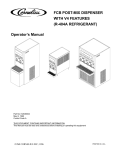
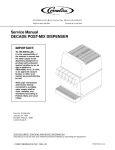
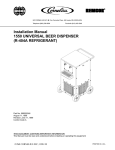
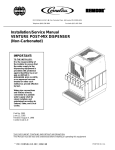
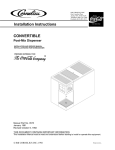
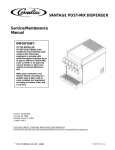
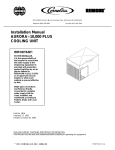
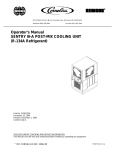
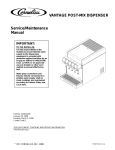
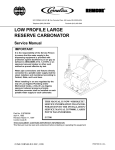
![Service Manual VA13 Carbonator [ 002818 ]](http://vs1.manualzilla.com/store/data/006013608_1-0f8f87056a0ab013b1dd01dac3912d47-150x150.png)

